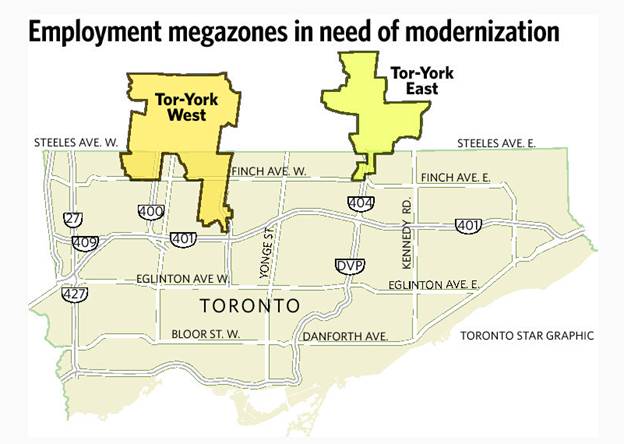
Curb commercial sprawl to attract talent: Report
Knowledge-economy workers in two GTA megazones will go where they can get downtown-style amenities.
TheStar.com
June 2, 2017
Tess Kalinowski
The Toronto region needs to stop building office parks surrounded by giant, parking lots on the fringes and start urbanizing its job zones, putting employment near transit and creating pedestrian friendly business parks.
Urban planner Pamela Blais says the same measures being used to curb housing sprawl need to apply to the commercial sector to cut congestion and ensure the region continues to attract the talent that will feed employment growth.
She has written detailed profiles of two of the region's longstanding employment megazones being published this week by the non-profit Neptis Foundation, which has been studying the impact of provincial anti-sprawl policies.
The study areas known as Tor-York East and Tor-York West both traverse Toronto and York Region. Combined, they represent about 245,000 jobs, mostly in industries that drive growth in the region and are economically significant in Canada.
While the Greater Golden Horseshoe lost jobs between 2001 and 2011, these two employment zones actually made gains.
There were 470,000 jobs downtown and about 300,000 in the Pearson airport employment megazone during the study period which ends in 2011, the year of the latest available statistics. There has been growth since, said Blais. Toronto, for example, put the number of downtown jobs at 511,000 last year.
Her reports track the loss of traditional manufacturing jobs in Tor-York East and West and the incursion of new knowledge-based industries — employers that covet top talent and a diverse labour pool.
But those workers will go where they can get downtown style amenities.
"You can't really talk about complete communities without talking about employment," said Blais. "There's a move away from the sterile business park to one where people are able to walk out to lunch and have a pizza without having to get in their car and drive.”

Emerging jobs are compatible with multi-storey office towers rather than low, spread-out manufacturing facilities. Redeveloping the surface parking lots and building on some vacant business park sites could free up space for up to 57,000 office workers, according to Blais.
Many of those offices would be in easy reach of new transit such as the Viva bus rapid transit (BRT) along Highway 7. But even that service, the subway to the Vaughan Metropolitan Centre and expanded two-way, all-day GO service won't be enough to put all workers in the megazones on transit, she said.
Employment megazones haven't been included in Ontario's recently updated Growth Plan, which has instead focused on residential growth, said Neptis executive director Marcy Burchfield.
Where York Region has introduced BRT, the planning is still focused on cars, she said.
"Even though the BRT is going through there, it's not friendly to pedestrians. When you go into where much of the financial business services are concentrated, they are still planned around surface parking lots and there are less amenities in them," said Burchfield.
Neptis's employment megazones are a microcosm of what's happening in the broad economy, she said.
"To realize the full potential of the megazones is really critical to the economic prosperity of our region," said Burchfield.
"That means restricting office development at the edges of the region. No more new suburban office parks. The 100 million sq. ft. of office space we're expecting to plan for over the next 25 years — we have to do that in a way that maximizes out transit investments and the economic potential," she said.
York Region officials say Blais's reports are proof that their urban planning is paying off in jobs. The amenities, they say, are coming.
"Both areas have done well to attract jobs in the knowledge-based economy that we've been moving towards," said Paul Freeman, manager of planning policy.
Vaughan Metropolitan Centre and Markham Centre have seen more than 1 million sq. ft. of new office development over the last four years, including facilities built or being development by KPMG, Miller Thomson, PwC and Aviva Canada, said Doug Lindeblom, director of economic strategy.
He cited Lenovo Canada, TD Insurance and General Motors developments south of Markham Centre in the employment megazone.
"We're building cities. We're building different kinds of cities than you'll see in downtown Toronto but the amenities are coming," he said, adding the office development has been driven by the development of about 10,000 condo units in the region over the last three years.
